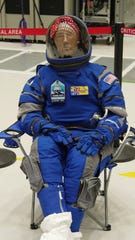A bandana-clad flight test dummy, named after 20th century feminist icon Rosie the Riveter, will be the first to fly on Boeing’s Starliner vehicle this week.
This Friday (Dec. 20), Boeing’s CST-100 Starliner spacecraft will make its inaugural trip to the International Space Station with its Orbital Flight Test (OFT). This will be a major step toward Starliner eventually carrying humans to space in the commercial vehicle. And to ensure the safety of these future space travelers, Boeing is sending along a special, inhuman passenger aboard Starliner with the OFT: Rosie the Astronaut, nicknamed “Rosie the Rocketeer” by some.
Now, Rosie isn’t actually an astronaut, she is an Anthropomorphic Test Device (ATD), or a flight test dummy. She looks just like a mannequin in a spacesuit. But she serves an incredible purpose.
Related: In Photos: Boeing’s Starliner Pad Abort Test Launch

Rosie is a brand-new ATD outfitted with a multitude of sensors that will monitor, measure and track critical data points, including the G-forces that Rosie experiences during the trip. Most of the sensors are strategically placed around the base of the skull, the neck and the base of the spine, Josh Barrett, the CST-100 Starliner Communications Specialist at Boeing, told Space.com. These sensors will provide teams back on Earth with critical data about what human astronauts might experience during their flights. This will be necessary to ensure that the future Starliner crews have safe flights to and from space.
This space-bound test “astronaut” will fly to the space station sitting in Starliner’s commander seat. Though the seat will be similar to the one that astronauts will sit in for future crewed flights, the seats that human astronauts will use will have 3D-printed inserts (compared to Rosie’s stock insert). Rosie’s spacesuit will also be very similar to what human crewmembers will wear on Boeing’s crewed flights, Barrett said.
Rosie got her name from one of the most popular icons of the 20th century, Rosie the Riveter, who became famous with the “We Can Do It” poster, which featured Rosie as a factory worker in a red polka-dot bandana, flexing her muscles. Rosie the Riveter served as a role model for working women during World War II and continues to serve as an inspiration for women around the world today.
Rosie the astronaut was named by Leanne Caret, president of Boeing’s Defense, Space & Security division, who hopes that the spacefaring Rosie will encourage women to join the aerospace workforce, Barrett said.
“Rosie is a symbol of not only the women who are blazing a trail in human spaceflight history, but also of everyone who has shown grit and determination while working tirelessly to ensure the Starliner can transport astronauts safely to and from the International Space Station,” Caret said in a statement. “She’s flying for everyone on our team who took on the challenge of human spaceflight and said, ‘We can do it.'”
Follow Chelsea Gohd on Twitter @chelsea_gohd. Follow us on Twitter @Spacedotcom and on Facebook.







